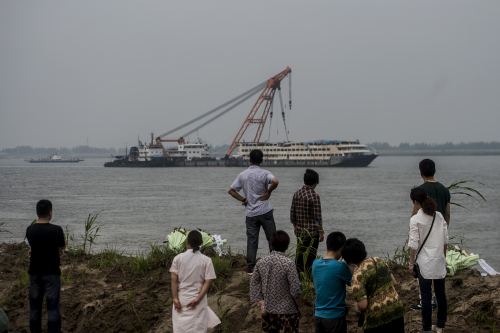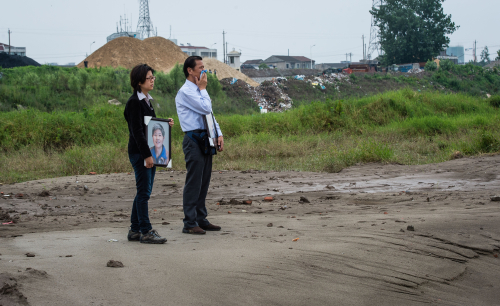|
 |
|
The capsized cruise ship Eastern Star is towed from thesite of the tragedy on June 10 (XINHUA) |
On June 8, search and rescue activities centered on a capsized cruise ship on the Yangtze River came to a halt.
The rescuers had only recently completed the clean up and search through of the cabins, a task they started immediately after the overturned vessel was righted and then pulled out of water on June 5.
As of the morning of June 8, 14 persons had survived, with 434 confirmed dead and another eight remaining unaccounted for, according to Xinhua News Agency.
After a thorough cleanup of the cruiser, an assessment team examined and eventually sealed the ship.
The Yangtze River navigation administration disclosed that the Eastern Star would be dragged away from the accident site and a group of experts would investigate the accident further.
On June 9, divers ceased their underwater search at the wreckage site, with no more missing persons found. Searches downstream from the accident continue.
Within the galleys
On June 5, the answers to many questions surfaced along with the Eastern Star as it was gradually hoisted out of the water, with its blue roof in tatters from the storm that had capsized it.
Donning protective garments, the rescuers boarded the ship and began to scour the cabins one by one for bodies. They also identified every possession and personal artifact they could find and recorded them. Sanitizer was routinely sprayed throughout the ship to prevent disease from spreading. Pumps were deployed to drain the water trapped within.
A clock on a cabin wall still displayed the time of the tragic incident on June 1--9:33 p.m.
Soaked sheets and quilts, shoes and kettles were strewn on the floor, with wooden bunk beds lying in pieces on all sides, according to a Xinhua reporter witnessing the search on board on June 6.
The remains of the vast majority of the missing persons were found in the ship's cabins. In one room, rescuers found the body of a three-year-old girl, the youngest passenger on board. The girl from Tianjin had joined her grandparents on the sightseeing tour that all of the passengers had been participating in. Her grandmother's body was found in the same cabin.
"The little girl still held a bag of biscuits in hand, very tightly," said Yu Yuanming, a firefighter with the fire brigade of Jingzhou, central China's Hubei Province.
Yu said upon seeing this, he and fellow rescuers could not help crying. They carefully carried her body off the ship and mourned for her.
Unexpected disaster
In many rooms on the Eastern Star, life jackets remained neatly stored in the cabinets, according to a Xinhua reporter that was allowed onboard on June 6. The disaster happened so suddenly that many people did not have time to put their jackets on.
Hu Jianyue, a 55-year-old survivor from Shanghai, recalled that on the evening of June 1, he felt the cabin that he shared with other passengers was too stuffy, so he wanted to go onto the deck on the fourth floor.
The rain was already pouring down at that point, so he waited in the recreation room on the second floor, where several people were playing mahjong. Suddenly, the ship tilted, throwing the table and the players to one side of the room. Before Hu could understand what exactly had happened, he found himself surrounded by water. He caught two life rings floating in water and put them around himself. Then another man came along and they shared a life ring. They drifted for more than four hours before being spotted by people on a passing boat, who called the coastguard that later saved them.
Zhang Hui, a 43-year-old tour guide and survivor, estimated that the ship overturned in less than a minute.
He sensed imminent trouble after seeing bottles tumbling to the floor. He and a colleague each grabbed a life jacket, and by then, the ship was already on its side and the window they used to escape positioned above them. Zhang drifted for 10 hours, merely holding onto the life jacket for he did not have time to put it on before getting into water. On his way, he saw some passing boats, but no one caught sight of him. At dawn, he found the river bank and swam ashore.
"In every room, there are life jackets," he told Xinhua, "Had the ship not overturned so rapidly, more people could have been saved."
During an interview with Xinhua, the Eastern Star's captain Zhang Shunwen said that at that time, the wind, blowing from south to north, was around grade 3-4 on the Beaufort scale. He wanted to deviate northward to align the ship with the wind, but when the wind suddenly and dramatically became much stronger, and the ship lost control.
The boat's chief engineer Yang Zhongquan said that one or two minutes after he entered the cabin during his patrol of the deck, water gushed in, and lights went off. "Then I felt that the boat had already turned over," he said.
Both the captain and chief engineer swam ashore and as of writing, they are in police custody.
 |
|
On the bank of the Yangtze River, Guan Yuan (left) and her uncle mourn her parents lost in the accident on June 7 (XINHUA) |
Handling the aftermath
After the accident, family members of some of the victims arrived at Jianli County of Hubei Province.
Upon learning of the ship accident, Guan Yuan and her uncle traveled all the way from Japan to Jianli to look for her parents. She went to Japan at the age of 12 with her parents, who worked in Japan until their retirement. This long-distance tour was the first the elderly couple had taken in their retirement. "My parents rarely traveled, so they could save money for my education," Guan told Xinhua.
Guan said that in Jianli, she was filled with both grief and gratitude. "So many people I have never met before tried their best to help us," she said.
At the highway exit to Jianli, they saw a reception desk for victim families. The local government had arranged food and lodging, and a volunteer driver brought them to a hotel.
A large memorial ceremony was held on June 7. Seven experts from Shanghai Mental Health Center arrived at Jianli on the same day to provide psychological counselling to victims' families.
China Insurance Regulatory Commission has asked insurance companies to set up claim settlement green channels for relatives of the victims. The commission's vice chairman Huang Hong said that the insurance claim procedures should be convenient, and compensation should be made in a timely fashion after proof had been presented by local governments.
Tao Fei, General Manager of the Shanghai Xiehe Travel Agency that organized the cruise tour, said that 359 tour members had purchased life insurance.
In addition, the government is investigating the cause of the shipwreck.
The Beijing News scrutinized the ship's building and renovation process. It found that the Eastern Star was constructed in the shipyard of the vessel's owner Chongqing Eastern Shipping Corp. based on a main structure built by Chongqing Chuandong Shipbuilding Co. Ltd., a subsidiary of China Shipbuilding Industry Corp.
The shipyard of Chongqing Eastern Shipping Corp. was not qualified for building cruisers, the newspaper found.
In 1997, the ship was upgraded from an ordinary passenger ship to a luxury cruiser.
The open porches on both sides of the ship were sealed up, and the doors facing the waters were converted to windows, said Liu Deyi, who once worked as a security guard on the vessel. Liu thought that this structural change made it difficult for passengers to escape in cases of emergency.
Liu also noticed the fixed iron double-decked beds were changed to wooden ones that were not fixed, which were free to slide to one side when the ship tilted, precipitating the turnover process.
Wu Jianqiang, a survivor who swam ashore, said that a sliding bed pinned her wife to the wall, stopping her from moving. Wu escaped through the window.
Industry experts said that extending the ship's length and adding interior decorations lifted the ship's center of gravity and made it less stable.
Moreover, the ship was not equipped with an automatic accident reporting system, according to Li Jiang, deputy head of the Yangtze River navigation administration. During the accident, the ship turned over so quickly that the crew did not have time to send an alarm manually. Reports were sent to the coastguard after some survivors made it to shore. With an automatic system, the rescue could have commenced earlier.
Copyedited by Kieran Pringle
Comments to wanghairong@bjreview.com | 